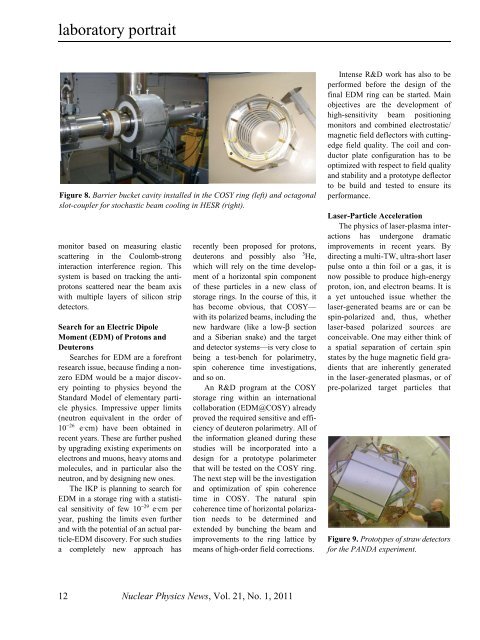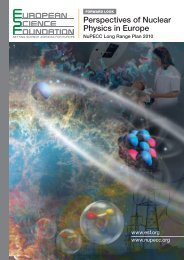Vol. 21 No. 1 - NuPECC
Vol. 21 No. 1 - NuPECC
Vol. 21 No. 1 - NuPECC
You also want an ePaper? Increase the reach of your titles
YUMPU automatically turns print PDFs into web optimized ePapers that Google loves.
laboratory portrait<br />
Figure 8. Barrier bucket cavity installed in the COSY ring (left) and octagonal<br />
slot-coupler for stochastic beam cooling in HESR (right).<br />
monitor based on measuring elastic<br />
scattering in the Coulomb-strong<br />
interaction interference region. This<br />
system is based on tracking the antiprotons<br />
scattered near the beam axis<br />
with multiple layers of silicon strip<br />
detectors.<br />
Search for an Electric Dipole<br />
Moment (EDM) of Protons and<br />
Deuterons<br />
Searches for EDM are a forefront<br />
research issue, because finding a nonzero<br />
EDM would be a major discovery<br />
pointing to physics beyond the<br />
Standard Model of elementary particle<br />
physics. Impressive upper limits<br />
(neutron equivalent in the order of<br />
10 −26 e·cm) have been obtained in<br />
recent years. These are further pushed<br />
by upgrading existing experiments on<br />
electrons and muons, heavy atoms and<br />
molecules, and in particular also the<br />
neutron, and by designing new ones.<br />
The IKP is planning to search for<br />
EDM in a storage ring with a statistical<br />
sensitivity of few 10 −29 e·cm per<br />
year, pushing the limits even further<br />
and with the potential of an actual particle-EDM<br />
discovery. For such studies<br />
a completely new approach has<br />
recently been proposed for protons,<br />
deuterons and possibly also 3 He,<br />
which will rely on the time development<br />
of a horizontal spin component<br />
of these particles in a new class of<br />
storage rings. In the course of this, it<br />
has become obvious, that COSY—<br />
with its polarized beams, including the<br />
new hardware (like a low-β section<br />
and a Siberian snake) and the target<br />
and detector systems—is very close to<br />
being a test-bench for polarimetry,<br />
spin coherence time investigations,<br />
and so on.<br />
An R&D program at the COSY<br />
storage ring within an international<br />
collaboration (EDM@COSY) already<br />
proved the required sensitive and efficiency<br />
of deuteron polarimetry. All of<br />
the information gleaned during these<br />
studies will be incorporated into a<br />
design for a prototype polarimeter<br />
that will be tested on the COSY ring.<br />
The next step will be the investigation<br />
and optimization of spin coherence<br />
time in COSY. The natural spin<br />
coherence time of horizontal polarization<br />
needs to be determined and<br />
extended by bunching the beam and<br />
improvements to the ring lattice by<br />
means of high-order field corrections.<br />
Intense R&D work has also to be<br />
performed before the design of the<br />
final EDM ring can be started. Main<br />
objectives are the development of<br />
high-sensitivity beam positioning<br />
monitors and combined electrostatic/<br />
magnetic field deflectors with cuttingedge<br />
field quality. The coil and conductor<br />
plate configuration has to be<br />
optimized with respect to field quality<br />
and stability and a prototype deflector<br />
to be build and tested to ensure its<br />
performance.<br />
Laser-Particle Acceleration<br />
The physics of laser-plasma interactions<br />
has undergone dramatic<br />
improvements in recent years. By<br />
directing a multi-TW, ultra-short laser<br />
pulse onto a thin foil or a gas, it is<br />
now possible to produce high-energy<br />
proton, ion, and electron beams. It is<br />
a yet untouched issue whether the<br />
laser-generated beams are or can be<br />
spin-polarized and, thus, whether<br />
laser-based polarized sources are<br />
conceivable. One may either think of<br />
a spatial separation of certain spin<br />
states by the huge magnetic field gradients<br />
that are inherently generated<br />
in the laser-generated plasmas, or of<br />
pre-polarized target particles that<br />
Figure 9. Prototypes of straw detectors<br />
for the PANDA experiment.<br />
12 Nuclear Physics News, <strong>Vol</strong>. <strong>21</strong>, <strong>No</strong>. 1, 2011
















